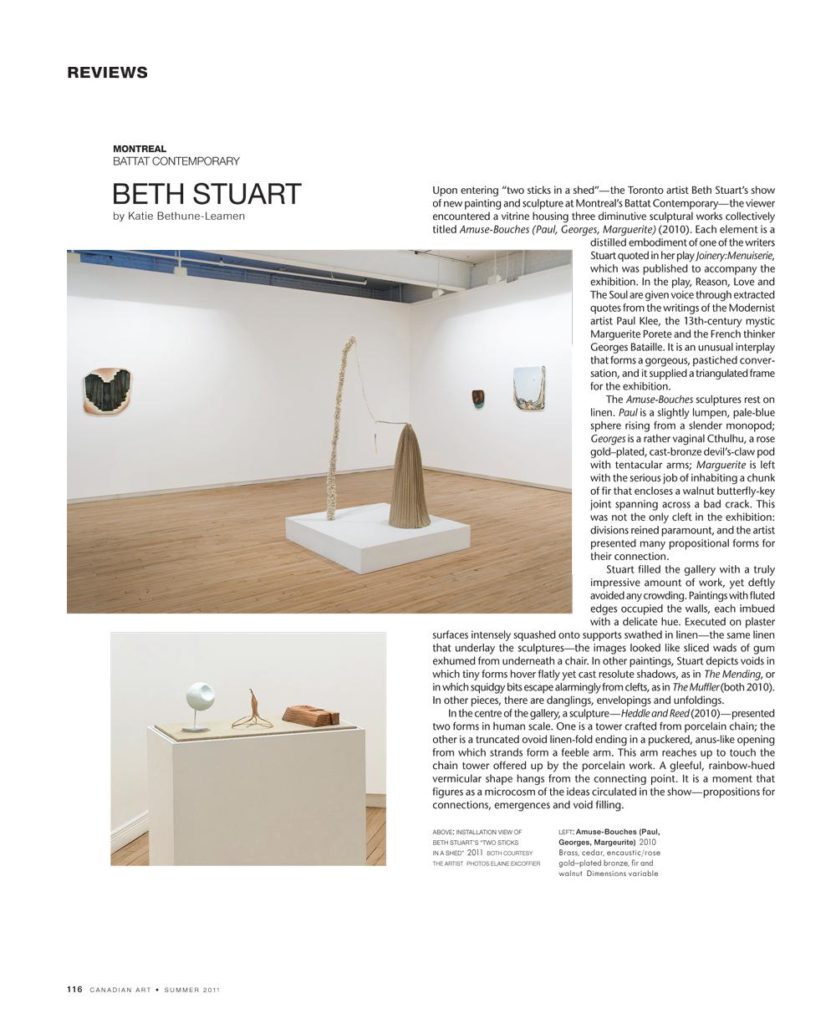Upon entering “two sticks in a shed”—the Toronto artist Beth Stuart’s show of new painting and sculpture at Montreal’s Battat Contemporary—the viewer encountered a vitrine housing three diminutive sculptural works collectively titled Amuse-Bouches (Paul, Georges, Marguerite) (2010). Each element is a distilled embodiment of one of the writers Stuart quoted in her play Joinery:Menuiserie, which was published to accompany the exhibition. In the play, Reason, Love and The Soul are given voice through extracted quotes from the writings of the Modernist artist Paul Klee, the 13th-century mystic Marguerite Porete and the French thinker Georges Bataille. It is an unusual interplay that forms a gorgeous, pastiched conversation, and it supplied a triangulated frame for the exhibition.
The Amuse-Bouches sculptures rest on linen. Paul is a slightly lumpen, pale-blue sphere rising from a slender monopod; Georges is a rather vaginal Cthulhu, a rose gold–plated, cast-bronze devil’s-claw pod with tentacular arms; Marguerite is left with the serious job of inhabiting a chunk of fir that encloses a walnut butterfly-key joint spanning across a bad crack. This was not the only cleft in the exhibition: divisions reined paramount, and the artist presented many propositional forms for their connection.
Stuart filled the gallery with a truly impressive amount of work, yet deftly avoided any crowding. Paintings with fluted edges occupied the walls, each imbued with a delicate hue. Executed on plaster surfaces intensely squashed onto supports swathed in linen—the same linen that underlay the sculptures—the images looked like sliced wads of gum exhumed from underneath a chair. In other paintings, Stuart depicts voids in which tiny forms hover flatly yet cast resolute shadows, as in The Mending, or in which squidgy bits escape alarmingly from clefts, as in The Muffler (both 2010). In other pieces, there are danglings, envelopings and unfoldings.
In the centre of the gallery, a sculpture—Heddle and Reed (2010)—presented two forms in human scale. One is a tower crafted from porcelain chain; the other is a truncated ovoid linen-fold ending in a puckered, anus-like opening from which strands form a feeble arm. This arm reaches up to touch the chain tower offered up by the porcelain work. A gleeful, rainbow-hued vermicular shape hangs from the connecting point. It is a moment that figures as a microcosm of the ideas circulated in the show—propositions for connections, emergences and void filling.
This is an article from the Summer 2011 issue of Canadian Art. To read more from this issue, please visit its table of contents.

 Spread from the Summer 2011 issue of Canadian Art
Spread from the Summer 2011 issue of Canadian Art







